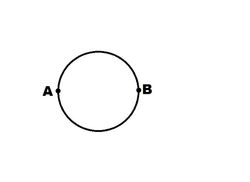Circular resistance?
 The figure above shows a wire of resistance 100
Ω
, which is bent to form a complete circle. If
A
and
B
are the two diametrically opposite points, find the resistance between them in
Ω
.
The figure above shows a wire of resistance 100
Ω
, which is bent to form a complete circle. If
A
and
B
are the two diametrically opposite points, find the resistance between them in
Ω
.
The answer is 25.
This section requires Javascript.
You are seeing this because something didn't load right. We suggest you, (a) try
refreshing the page, (b) enabling javascript if it is disabled on your browser and,
finally, (c)
loading the
non-javascript version of this page
. We're sorry about the hassle.
4 solutions
You can use Ω for ohm's. Anyways Cheers! ⌣ ¨
We can use the rule thats says when you have 2 identical resistors are connected in parallel . Req = one of the two resistors/ 2 So this circle will be divided into two resistors 50 ,50 so divide the 50 by 2 you will get 25ohm :)
see dear i still feel 25 is bin correct.. why if whole figure is bent in the form of a circle and you are finding solution first convert into terminal form then seek two points ... so 2xpixa=100 implies a=31.83
now you can half it to one fourth to find the exact answer 7.95 or 8 to be precise..
I don't think you can say the two wires you describe are in parallel. The same current goes through them, if you think about it
Using R = A ρ L it is clear that R ∝ L so halving the distance halves the resistance and both paths have R = 2 1 0 0 Ω = 5 0 Ω .
Since these paths are in parallel we use the reciprocal addition giving:
R A B 1 = 5 0 Ω 1 + 5 0 Ω 1 = 5 0 Ω 2 = 2 5 Ω 1 ⇒ R A B = 2 5 Ω
Parallel therefore 50*50/100
By Kirchoffs law Resutant 1/R = 1/R1 + 1/R2
Let A D B C A be the wire of resistance 1 0 0 ohms where A , B and C , D are diametrically opposite points. So the wires A D B and A C B will have resistances 5 0 ohms each and these two wires are joined in parallel between A a n d B . Hence the equivalent resistance is given by :
R e q v = 5 0 + 5 0 5 0 × 5 0 = 1 0 0 2 5 0 0 = 2 5 o h m s